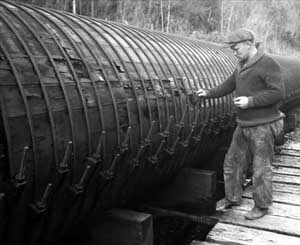On May 31, 1922, forest fires sweep across eastern King County destroying half the town of Cedar Falls. No lives are lost, but more than a dozen men are burned and hundreds of thousands of dollars in property is destroyed. Seattle City Light employees and their families survive only by taking refuge inside the Cedar Falls masonry dam. The City Light power plant is saved through the all-night efforts of Seattle Hose Company No. 34. This is one of several fires burning throughout Western Washington.
A Donkey Engine Throws Sparks
The fire was believed to have started from sparks from a steam-powered donkey engine at a logging operation on land owned by the Northern Pacific Railroad. (The donkey engine provided power for winches. It sat on skids and could be pulled or dragged from place to place.)
Ultimately, the fire consumed the north half of the town of Cedar Falls and the homes of 25 employees of the Chicago, Milwaukee, St. Paul & Pacific Railroad (Milwaukee Road) and several logging camps. When power lines for the Milwaukee Road's electric locomotives burned, rolling stock in the yard at Cedar Falls was immobilized and also burned. A tank full of fuel oil sent flames hundreds of feet into the air. Refugees found safety in the Milwaukee Road power house.
The Seattle Fire Department dispatched the four-man Hose Company No. 34 in its combination chemical and hose truck. They made their way to Cedar Falls by way of North Bend through the flames. The trip took two hours. Another 54 City Light employees boarded a special train from Seattle at 6:30 p.m. to join in the battle. Under the direction of Seattle Fire Department Lt. H. W. Fuson and his crew, the firefighters kept the flames away from City Light homes in Cedar Falls and from the hydro-electric power house there. When flames toppled a transmission tower, power was cut to Seattle for a short time.
The Lake Union Steam Plant was used to provide replacement power. Water Department employees bored holes every few feet in the wooden pipeline that carried drinking water from the Cedar River to Seattle. The sprinkler effect helped stop the flames.
Randall Rydeen Remembers
A witness to the fire, Randall Rydeen (1906-1998), grew up in Cedar Falls. His stepfather was a City of Seattle engineer located in Cedar Falls. Rydeen was 16 when the fire broke out. In 1993, he gave this account:
"We went to school [that day]. We looked up there at the mountain. When we left Camp 2, the wind was blowing and lightning was starting this fire up on Mount Washington, crown fires, and we got to school. We just got settled in school and Emmett came back and said we have to go up to camp, they need you up there to fight fire. So we took off for Cedar Falls.
"By the time we got up there the fire had gone all the way from Mount Washington clear down through all that area and it was burning those houses on Cedar Falls.
"Those was along the railroad tracks at Cedar Falls, just above Rattlesnake Lake. That fire jumped because of the snags there, and the wind was blowing and the fire spread like wildfire. We went into Rattlesnake Lake on the way up and wet gunnysacks and put over our heads, and Emmett drove on up to the power house in Cedar Falls and we got out and we walked over the pipeline all the way to Camp 2. That's the only way we could get up there.
"They had drilled holes in the pipeline walls, they went over wooden trestles and everything, and they would have burned, too. That is what saved them. We walked over that pipeline all the way to Camp 2, but it was easy to walk on because it was seven feet across.
"It burned all over, but they did save the pipeline and that was wooden.
"All they had at Camp 2 to fight the fire with was buckets to keep the ground damp around the houses. But they moved all their stuff out. We saved [Camp 2]. The women and children went down in the dam. There was an entrance on the back side. They went in there.
"We fought that fire about two or three days."
A Close Call
City Light Accountant C. E. "Westy" Westlund was ordered to stay on the telephone in the office at the power plant to keep a line of communications open. When the flames reached a gasoline tank nearby, he decided to leave, but the wind shifted and Westlund returned to his post.
Although the town of Cedar Falls was almost destroyed by a fire on Labor Day, 1919, this was the most serious fire in the state to date.
In addition to the losses suffered by the railroad, logging camps operated by lumber companies were devastated. In the first days after the fire, estimates of total losses exceeded $600,000.

